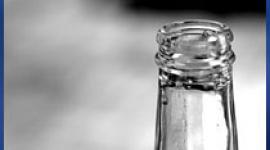Ten Radical Things NIAAA Research Shows About Alcoholism
 In the popular science periodical put out by the New York Academy of Sciences and the newsletter of the addiction division of the American Psychological Association, Stanton turns Project MATCH and other NIAAA and mainstream research on their ears to show that alcoholism cannot be dealt with as a medical disease. Instead, such research shows, even highly dependent drinking is an interchange between drinker and environment, shifts considerably over time, allows for moderated drinking, does not particularly respond to treatment (and almost not at all to standard, overly-aggressive 12-step therapy that dominates the American treatment scene), and responds best to brief helping interactions in which the drinker is the principal actor.
In the popular science periodical put out by the New York Academy of Sciences and the newsletter of the addiction division of the American Psychological Association, Stanton turns Project MATCH and other NIAAA and mainstream research on their ears to show that alcoholism cannot be dealt with as a medical disease. Instead, such research shows, even highly dependent drinking is an interchange between drinker and environment, shifts considerably over time, allows for moderated drinking, does not particularly respond to treatment (and almost not at all to standard, overly-aggressive 12-step therapy that dominates the American treatment scene), and responds best to brief helping interactions in which the drinker is the principal actor.
In the APA Division 50 newsletter, the president of Division 50 states, "Project MATCH delivered what it was paid to do," while Richard Longabaugh, who commented on Stanton's paper, noted, "This response is undertaken with considerable apprehension as it has been my impression over the years that offering a view at variance with Dr. Peele's is rarely 'a day at the beach.'" Please note the remarkable points of concurrence between the views Stanton expresses and those expressed by William Miller in his David Archibald Lecture, (see Addiction, 93:163-172, 1998).
The Addictions Newsletter (The American Psychological Association, Division 50), Spring, 1998 (Vol 5, No. 2), pp. 6; 17-19.
The National Institute on Alcohol and Alcoholism's (NIAAA) Project MATCH is the most elaborate clinical trial of psychotherapy ever conducted—in its ninth year, it has cost 30 million dollars and has involved most of this country's prominent clinical alcohol researchers. MATCH tested the hypothesis that alcohol treatment outcomes could be significantly improved by matching alcoholics on relevant dimensions with appropriate treatments. MATCH did not actually match alcoholics with treatments, but conducted a multivariate analysis on outcomes as predicted by a variety of traits in interaction with undergoing one of three types of treatment: Twelve-Step Facilitation (TSF), Cognitive-Behavioral Coping Skills Therapy (CBT), and Motivational Enhancement Therapy (MET).
MATCH results were reported in a long article by the collective Project MATCH Research Group (1997). None of the three treatments produced better outcomes overall, nor did any treatment produce better results for alcoholics with any given profile. Nearly all subjects were DSM-III-R alcohol dependent. Treatment was 12 weeks on an outpatient basis (for a purely outpatient group and a hospital treatment aftercare group), and patients were followed up for a year. Ten primary client characteristics were reported (e.g., motivation, psychiatric severity, gender). Outcomes were measured as days abstinent and drinks per drinking day. Among 64 tested interactions—16 proposed patient/treatment interactions by outpatient versus aftercare treatment by 2 outcome measures—one proved significant: in the outpatient group only, less psychiatrically severe subjects had 4 more abstinent days per month on average in TSF than in CBT treatment.
The idea of patient-treatment matching has for some time been regarded as the cutting edge in alcoholism treatment. The failure of MATCH's primary analysis to confirm the matching hypothesis revealed more than methodological oversights or the need for further analysis. It, along with other NIAAA and alcoholism research, shows that American conceptions of alcoholism and treatment policy are fundamentally wrong.
(1) The objectivist medical approach to alcoholism treatment does not work. Although psychologists were the primary movers in MATCH, MATCH typifies the modern medical approach to alcoholism which NIAAA director Enoch Gordis has promoted. In its aftermath, Gordis concluded, "Treatment matches may become apparent when we get to the core of the physiological and brain mechanisms underlying addiction and alcoholism." The idea underlying matching is often appropriate in medical treatment, but the failure to find benefit from matching contravenes the value of matching alcoholics to treatment based on their objective traits and symptoms. An alternate psychological approach is to allow alcoholics to select treatment types and goals based on their values and beliefs. Research by psychologists like Heather, Winton, and Rollnick (1982), Heather, Rollnick, and Winton (1983), Orford and Keddie (1986), Elal-Lawrence, Slade, and Dewey (1986), and Booth, Dale, Slade, and Dewey (1992), none American, has shown the superiority of subjective over objective matching, although this approach is not part of American alcoholism treatment.
(2) Individual and situational variables are more important for alcoholism outcomes than treatment variables. MATCH uncovered significant individual and setting factors including motivation and the drinking behavior of cohorts. In other words, MATCH found that outcomes of alcoholism were the results of who people are, what they want, where they reside, and who they spend time with. Alcoholism cannot productively be addressed like medical illnesses by relying on a strict diagnostic-treatment protocol.
This phenomenon is apparent in the overall results of MATCH. In several public presentations, MATCH researchers highlighted the overall improvement of patients, noting that subjects on average reduced drinking from 25 to 6 days per month and drank less on these days. However, this improvement occurred with alcoholics who were not typical of alcoholism patients in the United States. To start with, prospective subjects with simultaneous diagnosable drug problems were eliminated although, according to SAMHSA's (1997, February) national treatment admissions census (TEDS), "combined alcohol and drug abuse. . . [is] the most frequent problem at admission to substance abuse treatment."
Many additional filters were introduced by both the subjects and the researchers. Of 4,481 potential subjects identified, fewer than 1800 ultimately participated in MATCH. MATCH participants were volunteers, which places them at odds with the many coerced treatment referrals by the courts, employers, and social agencies. The MATCH team also eliminated potential subjects for reasons like "residential instability, legal or probation problems," etc. Another 459 potential subjects declined to participate because of the "inconvenience" of treatment. Subjects who actually participated in MATCH were more motivated, stable, noncriminal, and free of drug problems—all of which indicate greater likelihood of success. Thus overall MATCH results, like the MATCH analysis itself, illustrate that patients and their lives outside of treatment are more critical to alcoholism treatment results than the nature of their therapy.
(3) The characteristics of therapists and of interactions between patients and therapists are more important than type of treatment in alcoholism outcomes. While treatment type was not significant in MATCH, treatment site and site by treatment type effects were. In other words, the way particular therapists interacted with alcoholics had a substantial impact on patient outcomes whereas the label of the therapy they practiced did not.
(4) Alcoholism treatment in the United States is not notable for its success. Gordis's fundamental summary of MATCH was that while its findings "challenge the notion that patient-treatment matching is necessary for alcoholism treatment, the good news is that treatment works" (emphasis added; Bower, 1997). But MATCH could make no categorical statements about the impact of treatment since it had no untreated control comparison. Moreover, so much about the MATCH clinical trial was unique that there is little reason to assume its results generalize to alcoholism treatment at large in the United States. On the other hand, the NIAAA has conducted a thorough assessment of treated and untreated remission rates as experienced in the general population—the National Longitudinal Alcohol Epidemiologic Survey (NLAES)—based on face-to-face interviews about drug and alcohol use and treatment and concurrent emotional problems.
The NIAAA's Deborah Dawson (1996) analyzed over 4,500 NLAES subjects whose drinking at some point in their lives qualified for a diagnosis for alcohol dependence (DSM-IV). Treated alcoholics were more heavily alcohol dependent on average than untreated alcoholics and, according to the NIAAA's Bridget Grant (1996) in the same journal volume, to also have a drug problem (thereby distinguishing these from MATCH subjects). NLAES found that a third of treated (and 26% of untreated) subjects were abusing or dependent on alcohol in the past year. Of those whose alcohol dependence appeared within the last five years, 70 percent who received treatment were drinking alcoholically in the past year. Although population differences color comparisons between treated and untreated outcomes in NLAES, the results nonetheless show that alcoholics undergoing treatment in the United States do not experience the reliable improvement rosily reported by NIAAA/MATCH officials (see Table).
| Drinking over prior year | Treated (n=1,233) | Untreated (n=3,309) | Total (n=4,585) |
|---|---|---|---|
| Total population | |||
| % drinking with abuse/dependence | 33 | 26 | 28 |
| % abstinent | 39 | 16 | 22 |
| % drinking w/o abuse/dependence | 28 | 58 | 50 |
| Less than 5 years since onset of dependence | |||
| % drinking with abuse/dependence | 70 | 53 | 57 |
| % abstinent | 11 | 5 | 7 |
| % drinking w/o abuse/dependence | 19 | 41 | 36 |
| Note. From "Correlates of past-year status among treated and untreated person with former alcohol dependence: United States, 1992" by D. A. Dawson (1996) Alcoholism: Clinical and Experimental Research, 20, p. 773. Adopted with permission. | |||
(5) American twelve-step treatment is of limited usefulness. Any documented success of twelve-step treatment would reflect well on American alcoholism treatment, since Roman and Blum (1997), in their National Treatment Center Study, found that 93 percent of drug and alcohol programs follow the twelve-step program. Margaret Mattson (1997), a principal NIAAA MATCH coordinator, declared: "The results indicate that the Twelve Step model, . . . the most widely practiced . . . in the US, is beneficial." But this conclusion is not consistent with a meta-analysis of all available controlled alcoholism treatment studies reported by Miller et al. (1995). Unlike MATCH, Miller et al. found that alcoholism treatments were clearly differentiated in terms of their demonstrated effectiveness, with brief interventions ranked first, followed by social skills training and motivational enhancement. Ranked at the low end were confrontation and general alcoholism therapy. The two tests of AA found it inferior to other treatments or even no treatment but were not sufficient to rank AA reliably.
Remarkably, Miller et al. noted a strong inverse correlation between the popularity of treatments practiced in the US and the evidence that these treatments work, with the typical program comprising "a spiritual twelve-step (AA) philosophy . . . and . . . general alcoholism counseling, often of a confrontational nature," usually administered by former substance abusers. That this conventional treatment is not effective is consistent with NLAES results, although not with the impression created by MATCH.
(6) TSF in MATCH differed from standard twelve-step treatment, which is overly directive and otherwise poorly delivered. Treatment in MATCH was not the same as treatment in the field. Manuals were developed and counselors carefully selected and trained, each treatment session was videotaped, and the tapes were monitored by supervisors. Jon Morgenstern, as part of a Rutgers research project which has observed standard treatment providers, has noted that they offer very poor quality therapy. One way in which usual twelve-step therapy might differ from its MATCH version is that it is often highly directive (to the point of being abusive).
(7) The most cost-effective therapy for any severity alcohol problem is brief interventions/motivational interviewing—that is, short-term, nondirective treatment. In both brief interventions and motivational interviewing, therapies found most effective by Miller et al., patients and counselors jointly discuss the patient's drinking habits and consequences in a nonjudgmental way that focuses the patient on the value of reducing or quitting drinking. Meanwhile, Motivational Enhancement Therapy would be the recommended treatment based on MATCH because it produced equal results at far lower cost. TSF and CBT were designed to be 12 weekly sessions while MET was designed to be only four sessions. However, MATCH patients on average attended only two-thirds of their sessions, so that MET in MATCH approached brief interventions. That the briefest treatment in MATCH worked as well as more extensive treatments challenges conventional wisdom that brief interventions are inappropriate for alcohol-dependent patients.
(8) Elaborate alcoholism treatment is not necessary for recovery; most alcoholics in the United States recover without treatment. MATCH indicated that people who seek to overcome alcoholism and have a supportive social environment can well do so with brief therapeutic interactions that focus their motivation and resources on improving their lives. The NLAES analysis of untreated alcoholics shows (a) that most alcoholics do not seek treatment and (b) that most of these stop abusing alcohol (Dawson, 1996).
(9) Nonabstinent remission is standard for American alcoholics. Not only do most alcoholics improve significantly without treatment, but they typically do so without quitting drinking. According to NLAES, from five years following a dependence diagnosis on, a majority of ever-alcohol-dependent people in the US are drinking without manifesting alcohol abuse/dependence. Untreated alcoholics are more likely to be in remission than treated alcoholics at all points since dependence onset because, although they are less likely to abstain, they are far more likely to drink without diagnosed problems.
On September 8, 1997, U.S. News/World Report ran a cover story on controlled drinking (Shute, 1997, September 8). Gordis responded in the magazine (September 29) that "current evidence supports abstinence as the appropriate goal for person with the medical disorder 'alcohol dependence' (alcoholism)." Yet Gordis touted MATCH's excellent outcomes consisting of a reduction in the frequency and intensity of drinking by alcoholics! NIAAA's MATCH and NLAES results defy the irrational claims this agency (and American alcoholism treatment) make about abstinence as the desired—if largely unobtainable—goal for all alcoholics.
(10) The clinical tool used for the medical diagnosis of alcoholism confounds those who most strongly endorse the medical treatment of alcoholism. Possible resolutions of Gordis's views on abstinence with NIAAA research are (a) that those diagnosed alcohol dependent by DSM (both III-R and IV) are not really alcohol dependent and/or (b) that those categorized in remission are not. Untreated alcoholics in NLAES have less severe drinking problems than treated alcoholics. Perhaps they are not fully alcoholic. But what then is the significance of a DSM alcohol dependence diagnosis on which so many treatment decisions are made?
At the other end of the spectrum, the criticism might be that DSM-IV too readily finds drinkers are not categorizable as alcohol abusers/dependent. Many formerly dependent alcoholics in NLAES who now drink without abuse or dependence would not qualify for standard outcome definitions of moderate/social drinking. This is because American alcoholism researchers have become extremely cautious, not to say paranoid, about claiming that former alcoholics are drinking moderately. Yet, as indicated by the results MATCH proudly proclaimed, such reductions are clinically important. The public health term for this clinical improvement without full remission is "harm reduction."
Summary. NIAAA research shows that a medicalized conception of alcoholism and treatment is not suited to the nature and course of drinking problems. Project MATCH represents a massive effort to shoehorn a large amorphous peg into a small square hole. That it fails in this impossible task does not bother the health care industry, however. This is because, whether or not it accounts for the behavior of alcoholics, the medicalization of alcoholism succeeds in justifying the mission and policies of government and treatment agencies and professionals.
References
Booth, P.G., Dale, B., Slade, P.D., and Dewey, M.E. (1992). A follow-up study of problem drinkers offered a goal choice option. Journal of Studies on Alcohol, 53, 594-600.
Bower, B. (1997, January 25). Alcoholics synonymous: Heavy drinkers of all stripes may get comparable help from a variety of therapies. Science News, 151, 62-63.
Dawson, D.A. (1996). Correlates of past-year status among treated and untreated persons with former alcohol dependence: United States, 1992. Alcoholism: Clinical and Experimental Research, 20, 771-779.
Elal-Lawrence, G., Slade, P.D., and Dewey, M.E. (1986). Predictors of outcome type in treated problem drinkers. Journal of Studies on Alcohol, 47, 41-47.
Grant, B.F. (1996). Toward an alcohol treatment model: A comparison of treated and untreated respondents with DSM-IV alcohol use disorders in the general population. Alcoholism: Clinical and Experimental Research, 20, 372-378.
Heather, N., Rollnick, S., and Winton, M. (1983). A comparison of objective and subjective measures of alcohol dependence as predictors of relapse following treatment. British Journal of Clinical Psychology, 22, 11-17.
Heather, N., Winton, M., and Rollnick, S. (1982). An empirical test of "a cultural delusion of alcoholics." Psychological Reports, 50, 379-382.
Kadden, R.M. (1996, June 25). Project MATCH: Treatment main effects and matching results. Meeting of the Research Society on Alcoholism and the International Society for Biomedical Research on Alcoholism, Washington, DC.
Leary, W.E. (1996, December 18). Responses of alcoholics to therapies seem similar. New York Times, p. A17.
Mattson, M.E. (1997, March). Treatment can even work without triage: Initial results from Project MATCH. EPIKRISIS, 8(3), 2-3.
Miller, W.R., Brown, J.M., Simpson, T.L., Handmaker, N.S., Bien, T.H., Luckie, L.F., Montgomery, H.A., Hester, R.K., and Tonigan, J.S. (1995). What works?: A methodological analysis of the alcohol treatment outcome literature. In R.K. Hester and W.R. Miller (Eds.), Handbook of alcoholism treatment approaches (2nd Ed., pp. 12-44). Boston: Allyn and Bacon.
Orford, J., and Keddie, A. (1986). Abstinence or controlled drinking: A test of the dependence and persuasion hypotheses. British Journal of Addiction, 81, 495-504.
Project MATCH Research Group. (1997). Matching alcoholism treatments to client heterogeneity: Project MATCH posttreatment drinking outcomes. Journal of Studies on Alcohol, 58, 7-29.
Roman, P.M., and Blum, T.C. (1997). National treatment center study. Athens, GA: Institute of Behavioral Research, University of Georgia.
SAMHSA (1997, February). National admissions to substance abuse treatment services: The treatment episode data set (TEDS) 1992-1995 (Advance Report No. 12). Rockville, MD: Substance Abuse and Mental Health Services Administration, Office of Applied Studies.
Shute, N. (1997, September 8). The drinking dilemma. U.S. News and World Report, 54-65.
next: The Antidote to Alcohol Abuse: Sensible Drinking Messages
~ all Stanton Peele articles
~ addictions library articles
~ all addictions articles
APA Reference
Staff, H.
(2008, December 23). Ten Radical Things NIAAA Research Shows About Alcoholism, HealthyPlace. Retrieved
on 2024, June 20 from https://www.healthyplace.com/addictions/articles/ten-radical-things-niaaa-research-shows-about-alcoholism


